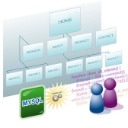Utter Shock and Amazement
Tuesday, July 21st, 2009
Today has been spent primarily on getting the PRIVMSG capability working on this custom-developed chat system. Because of the nature of the system, that is not allowing private chats, it was a lot more difficult than it needed to be. While I might have done things differently in the implementation, I wasn't involved and this system is in place and there's very little interest in really looking at this critically. It's "done", it "works", let it go.
I had to work with what I had.
That included the sum total of the code. It was a combination of C#, Python and assorted scripts and was virtually undocumented. It was a mess. But as far as messes go, it was something that I could dig into and get a few hints.
My primary debugging tool was the log of the socket data coming from the IRC server. It was literally invaluable. In the end, this is the interchange I discovered I needed to use in order to get person-to-person chatting, and therefore code-to-person chatting, working.
First, my code had to issue a special command to a particular "Overlord" bot that controlled the users on the IRC server. This in and of itself was interesting. They chose not to implement the rules in the server, but rather in a Bot that existed alongside the server.
When I send the appropriate command to this bot, I need to include the nick of the user I want to talk to. The Overlord then creates a channel just for the two of us with a special prefix, and the two user's names separated by a special character. Both users then get INVITEs to this new channel.
I have to wait for the INVITE, parse the channel invitation into the two user names, see which one is me, and which one is the "other guy", and then cache this data so that when I want to chat to the particular user, I can look up the special channel for this guy, and chat there, instead.
There were a ton of wrinkles with this scheme. First, because the process is asynchronous, I have to buffer my chats to this person if I need to create this channel. That is a pain, but doable with a little thought. Once I get the INVITE, I simply see if I have any buffered messages for this guy, and if I do, then I send them in order to the (newly JOINed) channel and we're back up to date.
Another one was the reconnection scheme - I simply took the point of view that on reconnection we'll do the minimum and each operation will ensure that everything is set up for that operation. It works, but it might be doing a little more "lazy" set-up than a different approach that would cache the channels, etc.
I have to say that everyone I've talked to in this place about these technical details is amazed that it has been done this way. The simplest way would have been to log everything in the server. Period. Database or flat files, or MySQL (combination of the two) would have worked. Then add in a simple authentication method on the server and you're done. Leave private chats as-is, but log them. Done.
It wasn't done this way, and I'm not sure what's going to happen in the long run. I've got this working, and that's the most important thing.





